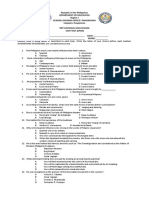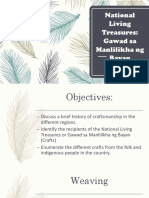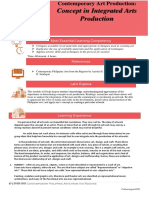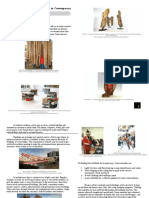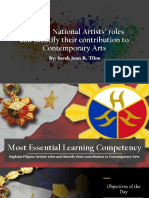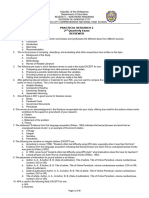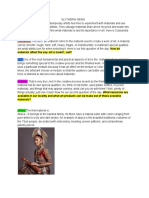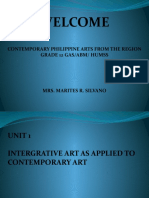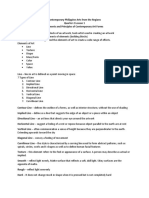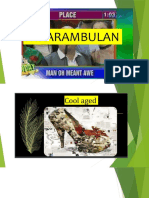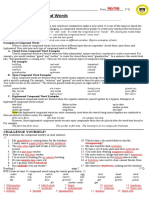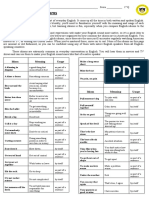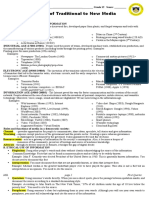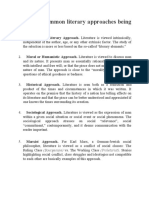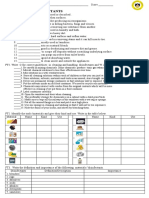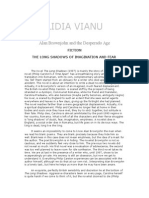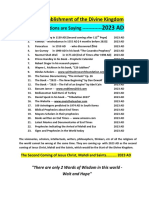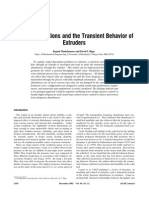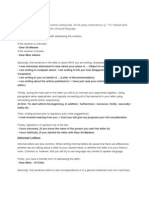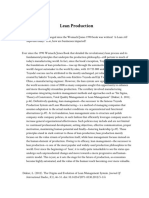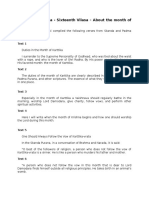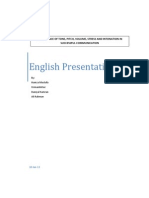2 Skills, Technique, Production and Appreciating Contemporary Art
2 Skills, Technique, Production and Appreciating Contemporary Art
Uploaded by
Asterio Ornopia AsaCopyright:
Available Formats
2 Skills, Technique, Production and Appreciating Contemporary Art
2 Skills, Technique, Production and Appreciating Contemporary Art
Uploaded by
Asterio Ornopia AsaOriginal Title
Copyright
Available Formats
Share this document
Did you find this document useful?
Is this content inappropriate?
Copyright:
Available Formats
2 Skills, Technique, Production and Appreciating Contemporary Art
2 Skills, Technique, Production and Appreciating Contemporary Art
Uploaded by
Asterio Ornopia AsaCopyright:
Available Formats
Contempo-
rary Art Name ________________ ________ Grade 12 Score:
MODULE
2 Skills, Technique, Production and
Appreciating Contemporary Art
A. Styles and Technique
Many contemporary artist do not have formal studies in the fine arts but are self-taught. Concerned with the development of
their talent and skills in art-making, they study on their own, interact with artist and read a lot about lives of artist and their works.
They also explore the material in hardware stores, experience with chemical reactions on their base materials. There are those who
learn welding and simple engineering skills. Some hire resin makers, house painters and materials fabricators to help them in
constructing their artworks. There are different types of techniques that artists can choose from:
Collage -It is made by adhering flat elements such as newspaper or magazine cut-outs, printed texts, illustrations,
photographs, cloth, string, etc. to a flat surface to create a thick layer that is almost like a relief sculpture.
Decalcomania -It is the process of applying gouache to paper or class then transferring a reversal of that image onto
canvas or other flat materials.
Decoupage - It is done by adhering cut-outs of paper and then coating these with one or more coats or transparent coating
of varnish.
Frottage -It is the technique of rubbing with crayon on a piece of paper which has been placed over an object or image.
The impression of the image can be created by using leaves, woods, wire screen, or metal with embossed image or words.
Montage - It is used for photography or film where a pictorial image is juxtaposed or placed overlapping to make another
picture or design.
Trapunto - It is the technique used by Pacita Abad where her canvas are padded, sewn, and often filled with sequins,
beads, shells, buttons, tiny mirrors, bits of grass, rickrack, swatches of precious textiles and other things that she pick up
from her travels and journeys.
Digital application for art viewing is another technique that comes with the augmented reality
B. Description Applied to Contemporary Art
There are three elements that constitute description of contemporary art: what the artwork is all about (subject matter),
what materials/medium were used in the process of art making, and the art elements, and principles. At this point, we do not yet
make any judgement.
Subject Matter is what you see that is depicted in the artwork. It may be human form where the figure are engaged in an
activity, or a combination of texture and color. It may also be figure made from found objects put together or assembled into a
coherent whole.
Material is what the artwork is made of. It can also be a combination of objects used in the artwork.
Art elements and principles refer to the physical qualities of the image. The artist uses color, lines, space and other
elements to create visual image. These are arranged into an organized manner that observes unity, harmony, rhythm, or other
principles of design in a creative way.
C. Analysis and Interpretation in Contemporary Art
Aesthetic- is a branch of philosophy that explores the nature of art, beauty, and taste, with the creation and
appreciation of beauty. It appreciate, understand and judge the value of art. An aesthetic judgement should be neither personal nor
relative. Viewers should rise above time, place and personal biases. This is also called Psychic distance (a term which has at least
three distinct means across the fields of aesthetics, international business/international
marketing, and computer science)
Art Analysis starts with a description of an art. Here viewers focuses on beauty, design qualities and value of art work and
pays close attention to which art elements the artist used: line, shape, color, value, texture, & space. (form is 3d and will not apply
to painting critiques). and also looks for ways the elements were used to organize the composition using rhythm, balance,
movement, proportion, variety, emphasis, and unity.
Art Interpretation is employed by the viewer after describing and analyzing an artwork. Here, focus is on the expressive
qualities, the meaning, theme, mood, or idea communicated by the artist.
Challenge Yourself
FT1 Checking Understanding Answer the questions below:
1. What are the different types of techniques in art making? Describe each technique. Collage, Montage, Frottage, Trapunto, Digital
Application, Delacomania, Decoupage.
2. How are interactive and collaborative art done by the contemporary artist? You can employ others people or expertise.
3. What are the three elements that constitute description in contemporary art? Subject Matter, Material, Art elements and principle.
4. Define each element by citing scope of each one. Color, Lines, Shapes, Figures and Space.
5. Who are the modern philosophers, scholars and artists who have influenced the perception of contemporary? Picasso and Braque
6. What are the characteristics of modern art? The use of recycled material or material you can anywhere.
7. How does post-modern art differ from modern art? Mixed of Materials
FT2 Completing Ideas Complete the following clauses into a sentence:
1. Art production requires skills and techniques such as Collage, Montage, Frottage, Trapunto, Digital Application, Delacomania,
Decoupage.
2. Digital application can enhance art making by augmentation of reality through of the use technology.
3. Interactive and collaborative art production can benefit the artists and the public by easy access to art making and building huge
art.
4. Art form is achieved in the sculpture by different material combination such as wood and metal, plastic and metal etc.
5. The sculpture appears light despite the brass material because it is easier to manipulate than other metals.
6. It can be said that the artist has achieved mastery of use of the material because most of his art are made of the specific and he
able convey meanings within the used of the material.
7. It is important for viewers to understand the philosophy, theories, and issues that shaped contemporary art because to avoid
personal judgement of art.
8. Art analysis starts with description, where art elements and principle can be found.
9. Analysis requires also the looks for ways the elements were used to organize the composition using rhythm, balance, movement,
proportion, variety, emphasis, and unity.
10. Art interpretation involves focus of the expressive qualities, the meaning, theme, mood, or idea communicated by the artist.
FT3 Identifying Style. Identify what style is being describe in each statement.
Digital Art 1. A technique that comes with the augmented reality
Trapunto 2. Technique used padded, sewn, and often filled with sequins, beads, shells, buttons, tiny mirrors, etc.
Art Interpretation 3. Employed by the viewer after describing and analyzing an artwork.
Decalcomania 4. Process of applying gouache to paper or glass then transferring a reversal of that image onto canvas
Collage 5. Made by adhering flat elements such as newspaper or magazine cut-outs, printed texts, illustration
Art Analysis 6. Focuses on beauty, design qualities and value of art work
Subject Matter 7. What you see that is depicted in the artwork
Material 8. It can also be a combination of objects used in the artwork.
Art Elements 9. Refer to the physical qualities of the image like the color, lines, space and other elements to create
visual image.
Aesthetics 10. A branch of philosophy that explores the nature of art, beauty, and taste, with the creation and
appreciation of beauty.
Montage 11. Used for photography or film where a pictorial image is juxtaposed
Frottage 12. The technique of rubbing with crayon on a piece of paper, which has been placed over an object or image.
Decoupage 13. Done by adhering cut-outs of paper and then coating these with one or more coats or transparent
coating of varnish, etc.
-end-
You might also like
- Reading 5 M2 Inferring Personality TraitsDocument2 pagesReading 5 M2 Inferring Personality TraitsAsterio Ornopia AsaNo ratings yet
- Module 6 Types of PhrasesDocument3 pagesModule 6 Types of PhrasesAsterio Ornopia Asa100% (1)
- Contemporary Arts: Lesson 1: Artistic Skills and TechniquesDocument4 pagesContemporary Arts: Lesson 1: Artistic Skills and TechniquesCloue Faye I. BasalloNo ratings yet
- Module 3 African FolktalesDocument2 pagesModule 3 African FolktalesAsterio Ornopia Asa100% (3)
- Module 3 African FolktalesDocument2 pagesModule 3 African FolktalesAsterio Ornopia Asa100% (3)
- Artistic Skills and Techniques To Contemporary Art CreationsDocument44 pagesArtistic Skills and Techniques To Contemporary Art Creationszell100% (1)
- Characteristics of Contemporary ART: Philippine Arts From The RegionsDocument10 pagesCharacteristics of Contemporary ART: Philippine Arts From The RegionsSheena Kay Canonigo AbarcaNo ratings yet
- CPAR Final ModuleDocument6 pagesCPAR Final ModuleMarilyn DizonNo ratings yet
- Acquired Skills EnhancementsDocument3 pagesAcquired Skills EnhancementstinNo ratings yet
- Cpar11&12 - Sem1&2 - Clas9 - Landscape Drawing An Incorporation of Contemporary Characteristics - v2 - For Ro-Qa - Carissa CalalinDocument13 pagesCpar11&12 - Sem1&2 - Clas9 - Landscape Drawing An Incorporation of Contemporary Characteristics - v2 - For Ro-Qa - Carissa CalalinKaren Ann ParangueNo ratings yet
- Contemporary Art PracticesDocument2 pagesContemporary Art PracticesRodrick Sonajo RamosNo ratings yet
- Cpar W1Document5 pagesCpar W1Rutchel100% (1)
- Various Art Forms in The Philippines Quarter 1 - Module 2: Contemporary Philippine Arts From The RegionDocument28 pagesVarious Art Forms in The Philippines Quarter 1 - Module 2: Contemporary Philippine Arts From The RegionMhay Anne Perez100% (1)
- Contexts ArtDocument67 pagesContexts ArtDanna Mae Terse Yuzon67% (3)
- 8 National Living Treasures Award or Gawad Sa Manlilikha NG BayanDocument8 pages8 National Living Treasures Award or Gawad Sa Manlilikha NG BayanCarel Faith AndresNo ratings yet
- CPAR - Module 4Document29 pagesCPAR - Module 4Jwhll MaeNo ratings yet
- Contemporary Philippine Arts From The RegionsDocument24 pagesContemporary Philippine Arts From The RegionsMa. Cecille AbanillaNo ratings yet
- CPARRRDocument21 pagesCPARRRRoselyn Lictawa Dela CruzNo ratings yet
- Skills, Techniques & Production in Contemporary ART: Lesson 4Document24 pagesSkills, Techniques & Production in Contemporary ART: Lesson 4Ella Shaine BeceraNo ratings yet
- Cpar Unit TestDocument3 pagesCpar Unit TestFelyn DelaCruz - DalinoNo ratings yet
- LESSON 4 - Contemporary Philippine Arts From The RegionDocument12 pagesLESSON 4 - Contemporary Philippine Arts From The RegionAlex Abonales Dumandan100% (12)
- Chapter 1 Lesson 1 - The Characteristics of Contemporary ArtDocument37 pagesChapter 1 Lesson 1 - The Characteristics of Contemporary ArtAngelika ValenciaNo ratings yet
- Contemporary Philippine Arts From The Region Q2 Module 3 4 Week 3 4Document9 pagesContemporary Philippine Arts From The Region Q2 Module 3 4 Week 3 4LeiRne Jo KBahingawan TanGuidNo ratings yet
- Contemporary Arts Reviewer and Notes Grade 12Document5 pagesContemporary Arts Reviewer and Notes Grade 12ケン トNo ratings yet
- Contemporary Philippine Arts Lesson 9-10Document6 pagesContemporary Philippine Arts Lesson 9-10Joey TaduranNo ratings yet
- CPAR WeavingDocument15 pagesCPAR WeavingRachel Sam DimalantaNo ratings yet
- CPAR ReviewerDocument6 pagesCPAR ReviewerShaira Bautista100% (1)
- Jenica Timeline of Evolution of MediaDocument1 pageJenica Timeline of Evolution of MediaKira Reyzzel CataminNo ratings yet
- 617944813d46c Art Analysis and Interpretation of Pacita Abad S Puerto Galera IV and Michael Cacnio S BalloonsDocument5 pages617944813d46c Art Analysis and Interpretation of Pacita Abad S Puerto Galera IV and Michael Cacnio S BalloonsBanana QNo ratings yet
- Contemporary Philippine Arts From The Regions: Various Contemporary Art FormsDocument5 pagesContemporary Philippine Arts From The Regions: Various Contemporary Art FormsCessá100% (2)
- Lesson 3 - Contemporary Art of The Philippines - Concept and ProductionDocument2 pagesLesson 3 - Contemporary Art of The Philippines - Concept and ProductionDan LexNo ratings yet
- Ppt.-Lesson 3Document56 pagesPpt.-Lesson 3maria genioNo ratings yet
- SUMMATIVE TEST IN CparDocument4 pagesSUMMATIVE TEST IN CparcindyNo ratings yet
- New Text DocumentDocument2 pagesNew Text DocumentTttte TeeeNo ratings yet
- Concept in Integrated Arts Production: LessonDocument2 pagesConcept in Integrated Arts Production: LessonLhaika Maureen CasisNo ratings yet
- Module 5 American Colonial PeriodDocument8 pagesModule 5 American Colonial PeriodShane SaynoNo ratings yet
- Essence of The Contemporary Arts of The PhilippinesDocument1 pageEssence of The Contemporary Arts of The PhilippinesAra LimNo ratings yet
- Contemporary Arts From The Region 2 Semester - 1 Quarter - : ND STDocument11 pagesContemporary Arts From The Region 2 Semester - 1 Quarter - : ND STRienalyn GalsimNo ratings yet
- Lesson 4: Materials and Techniques in Contemporary ArtDocument8 pagesLesson 4: Materials and Techniques in Contemporary ArtYukiko HachiNo ratings yet
- Cpar Integrative ArtDocument13 pagesCpar Integrative ArtDonna Mae Icabandi Teñoso50% (2)
- Contemporary Philippine Arts From The Regions - 12 - Q2 - M1 - Materials and Application of Techniques in Contemporary Arts - V4Document21 pagesContemporary Philippine Arts From The Regions - 12 - Q2 - M1 - Materials and Application of Techniques in Contemporary Arts - V4Rex Chambers LadaoNo ratings yet
- CPAR Lesson 3 - National Artists AwardsDocument33 pagesCPAR Lesson 3 - National Artists AwardsPammy AlivenNo ratings yet
- Gawad Sa Mga Manlilikha NG Bayan (Gamaba)Document32 pagesGawad Sa Mga Manlilikha NG Bayan (Gamaba)Allysa Lacorte100% (1)
- Template For The Activity Week 5Document9 pagesTemplate For The Activity Week 5Sher-Anne Fernandez - BelmoroNo ratings yet
- Learning Task 2 Short AnswerDocument1 pageLearning Task 2 Short AnswerB04 Miguel Joseph BatchNo ratings yet
- LESSON 1: The Contemporary in Traditional Art: Gawad Sa Manlilikha NG Bayan (Gamaba)Document12 pagesLESSON 1: The Contemporary in Traditional Art: Gawad Sa Manlilikha NG Bayan (Gamaba)nashRamosNo ratings yet
- CPAR Week 2 - FinalDocument6 pagesCPAR Week 2 - FinalRutchelNo ratings yet
- 2nd Quarter Summative Assessment ContemporaryDocument2 pages2nd Quarter Summative Assessment Contemporaryjessica coronelNo ratings yet
- PR2 2nd QTR Exam 2023-2024 - ReviewerDocument6 pagesPR2 2nd QTR Exam 2023-2024 - ReviewerlizaricahavilaNo ratings yet
- Materials Affect The Way Art Is Made?, Jed?Document7 pagesMaterials Affect The Way Art Is Made?, Jed?yoursytuly100% (1)
- Welcome: Contemporary Philippine Arts From The Region Grade 12 Gas/Abm/ HumssDocument16 pagesWelcome: Contemporary Philippine Arts From The Region Grade 12 Gas/Abm/ Humssmarites silvanoNo ratings yet
- Subject Matter and Style in Contemporary ArtDocument27 pagesSubject Matter and Style in Contemporary ArtKent Peter CuadradoNo ratings yet
- 7 Categories of National Artist of The PhilippinesDocument9 pages7 Categories of National Artist of The PhilippinesJustine Roi Santos CastroNo ratings yet
- CparDocument6 pagesCparI Don't Know100% (1)
- National Artists of The Philippines: Lesson 5Document23 pagesNational Artists of The Philippines: Lesson 5ROCELYN IMPERIALNo ratings yet
- Cpar q2 ReviewerDocument10 pagesCpar q2 ReviewerJaslor LavinaNo ratings yet
- Contemporary Art ProductionDocument14 pagesContemporary Art ProductionDarlene Jasmae Tiña100% (2)
- Skills Techniques and Production in Contemporary ArtDocument36 pagesSkills Techniques and Production in Contemporary ArtRoselyn Lictawa Dela CruzNo ratings yet
- Contemporary Philippine Arts From The Regions 1Document70 pagesContemporary Philippine Arts From The Regions 1Sofia ReyesNo ratings yet
- Cpar Long QuizDocument3 pagesCpar Long Quizdarunday charesmaNo ratings yet
- CPAR Week 6Document8 pagesCPAR Week 6Marilyn Dizon100% (1)
- Local Materials Used in Contemporary ArtsDocument26 pagesLocal Materials Used in Contemporary ArtsJusua Martinez NatabioNo ratings yet
- Contemporary Arts Grade 12 Module 4Document18 pagesContemporary Arts Grade 12 Module 4Fil Am Tugade100% (1)
- Module 10Document20 pagesModule 10Bhong Vicencio BacaltosNo ratings yet
- Reading 6 M4 Sequencing EventsDocument2 pagesReading 6 M4 Sequencing EventsAsterio Ornopia AsaNo ratings yet
- Reading 6 M2 Types of Context CluesDocument2 pagesReading 6 M2 Types of Context CluesAsterio Ornopia AsaNo ratings yet
- Reading 5 M5 Compound WordsDocument2 pagesReading 5 M5 Compound WordsAsterio Ornopia AsaNo ratings yet
- Reading 6 M3 Noting DetailsDocument2 pagesReading 6 M3 Noting DetailsAsterio Ornopia Asa100% (2)
- Reading 5 M6 Using IdiomsDocument3 pagesReading 5 M6 Using IdiomsAsterio Ornopia AsaNo ratings yet
- Module 7 Introduction To SyntaxDocument2 pagesModule 7 Introduction To SyntaxAsterio Ornopia Asa100% (1)
- Reading 5 M5 Compound WordsDocument2 pagesReading 5 M5 Compound WordsAsterio Ornopia AsaNo ratings yet
- Module 8 Context CluesDocument2 pagesModule 8 Context CluesAsterio Ornopia AsaNo ratings yet
- Module 2 African MythsDocument2 pagesModule 2 African MythsAsterio Ornopia Asa100% (3)
- Module 2 African MythsDocument2 pagesModule 2 African MythsAsterio Ornopia Asa100% (3)
- Module 4 African EpicDocument2 pagesModule 4 African EpicAsterio Ornopia Asa0% (2)
- Module 4 African EpicDocument2 pagesModule 4 African EpicAsterio Ornopia Asa0% (2)
- Module 1: Characteristic, Subject Matter and Style in Contemporary ArtDocument37 pagesModule 1: Characteristic, Subject Matter and Style in Contemporary ArtAsterio Ornopia AsaNo ratings yet
- Contemporary Arts: Grade 12Document17 pagesContemporary Arts: Grade 12Asterio Ornopia AsaNo ratings yet
- Module 2 Literature During The Spanish PeriodDocument2 pagesModule 2 Literature During The Spanish PeriodAsterio Ornopia AsaNo ratings yet
- Types of Media: Print, Broadcast and New MediaDocument2 pagesTypes of Media: Print, Broadcast and New MediaAsterio Ornopia AsaNo ratings yet
- Indigenous Media and Information and Evaluating Information: Medlit 12 - Page 2-First QuarterDocument2 pagesIndigenous Media and Information and Evaluating Information: Medlit 12 - Page 2-First QuarterAsterio Ornopia AsaNo ratings yet
- Evolution of Traditional To New MediaDocument3 pagesEvolution of Traditional To New MediaAsterio Ornopia AsaNo ratings yet
- The More Common Literary Approaches Being Used IncludeDocument2 pagesThe More Common Literary Approaches Being Used IncludeAsterio Ornopia AsaNo ratings yet
- 21st Century LiteratureDocument4 pages21st Century LiteratureAsterio Ornopia AsaNo ratings yet
- Tle 8Document2 pagesTle 8Asterio Ornopia AsaNo ratings yet
- Lesson Plan in Afa Agri-Crop ProductionDocument13 pagesLesson Plan in Afa Agri-Crop ProductionJohnCzyril Deladia DomensNo ratings yet
- Supra SexDocument9 pagesSupra SexĐỗ TínNo ratings yet
- The Long ShadowsDocument15 pagesThe Long ShadowsJason LongNo ratings yet
- Four Models of The Creative IndustriesDocument16 pagesFour Models of The Creative Industries2lieNo ratings yet
- The Establishment of The Divine Kingdom: The Nations Are SayingDocument2 pagesThe Establishment of The Divine Kingdom: The Nations Are SayingSyed AbidiNo ratings yet
- How To Read The Bible CritiqueDocument13 pagesHow To Read The Bible CritiqueJeff Kennedy100% (1)
- Robin CVDocument6 pagesRobin CVAulya MuctNo ratings yet
- Some Statistical Methods in AnachemDocument39 pagesSome Statistical Methods in AnachemshaineNo ratings yet
- HRD Flow Chart Pps 398Document3 pagesHRD Flow Chart Pps 398pooja.kssingh100% (1)
- Process Variations and The Transient Behavior of Extruders: Rajath Mudalamane and David I. BigioDocument11 pagesProcess Variations and The Transient Behavior of Extruders: Rajath Mudalamane and David I. BigioIbrahimFikryNo ratings yet
- 0 0 Anderson Chester PROSPECTUS I Ching and The Systems of The WestDocument34 pages0 0 Anderson Chester PROSPECTUS I Ching and The Systems of The WestPerlim Pim PomNo ratings yet
- Conversation From WebDocument4 pagesConversation From Weblixin94No ratings yet
- FJFHDocument9 pagesFJFHAnonymous qeb9vp17atNo ratings yet
- Formal, Informal LettersDocument2 pagesFormal, Informal LettersRodica StoianNo ratings yet
- ChordsDocument3 pagesChordsEirojram MarjorieNo ratings yet
- Beam de Ections: Second-Order MethodDocument11 pagesBeam de Ections: Second-Order MethodBesi StahlNo ratings yet
- Giles. The Uncanonical Gospels and Other Writings. 1852. Volume 1.Document488 pagesGiles. The Uncanonical Gospels and Other Writings. 1852. Volume 1.Patrologia Latina, Graeca et Orientalis100% (2)
- Islam CscopeDocument24 pagesIslam CscopeElina JukesNo ratings yet
- Edu 347 - Task An Chain ProjDocument17 pagesEdu 347 - Task An Chain Projapi-442154483No ratings yet
- Lean ProductionDocument2 pagesLean ProductionFilip SlavchevNo ratings yet
- SwHarihar - Yoga-Sutras-of-Patanjali INGLES-ESPAÑOLDocument24 pagesSwHarihar - Yoga-Sutras-of-Patanjali INGLES-ESPAÑOLEmilio AsensioNo ratings yet
- Kartika MasaDocument35 pagesKartika MasaUdayKiranGopalamNo ratings yet
- Encoding ArchitectureDocument280 pagesEncoding ArchitectureMohammed Younus AL-Bjari100% (3)
- ImpORTANCE of Tone Pitch VolumeDocument5 pagesImpORTANCE of Tone Pitch VolumealborgalNo ratings yet
- Introduction To Linguistic and Linguistic Meaning LET 103Document21 pagesIntroduction To Linguistic and Linguistic Meaning LET 103Shafiq Hamka ShahfawiNo ratings yet
- Variation Orders PPT FinalDocument13 pagesVariation Orders PPT FinalAdeNo ratings yet
- Food and Drink Lesson Plan Focus TextbookDocument3 pagesFood and Drink Lesson Plan Focus TextbookStarr Blue50% (2)
- Planning and SchedulingDocument65 pagesPlanning and Schedulingrachid19027467% (3)
- Luận văn thac si triet hoc hoan chinh Hoàng Thị NgânDocument100 pagesLuận văn thac si triet hoc hoan chinh Hoàng Thị NgânAnh KhoaNo ratings yet


















